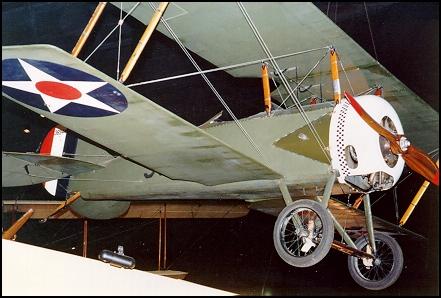

 |
| Span | 26 ft. 6 in. |
| Length | 19 ft. 10 in. |
| Height | 8 ft. 1 in. |
| Weight | 1,330 lbs. |
| Armament | One .30-cal Marlin machine gun |
| Engine | Le Rhone C-9 rotary |
| Horsepower | 80 |
| Maximum Speed | 95 Mph |
| Range | 250 miles |
| Rate of climb | 10,000 in 12 minutes |
| Service Ceiling | 16,000 ft. |
The Thomas-Morse "Scout" was the favorite single-seat training airplane produced in the U.S. during WW I. Dubbed the "Tommy" by the pilots of 1917, the plane had a long and varied career. It first appeared in the summer of 1917 as the S4B, 100 of which were ordered. A slightly modified version, the S4C, was later developed and 497 were purchased by the U.S. Air Service.
Scouts were used at practically every pursuit flying school in the U.S. during 1918. After the war ended, many were by reserve units of the Navy or sold as surplus to civilian flying schools, sportsman pilots, and ex-Army fliers. Some were still being used in the mid-1930s by reserve units and for WW I aviation movies filmed in Hollywood. Even to the present time, several Scouts are being flown by aviation buffs in the U.S.
The Scout in the photo was donated to the U.S. Air Force Museum in March 1965 by Capt. R. W. Duff, Miami, Florida. It was later restored by Aero Mechanics High School, Detroit, Michigan. This aircraft is similar to the ones that were flown at Grosse Ile.
Copyright © 2000NASGIVM All rights reserved.
Revised: June 30, 2010